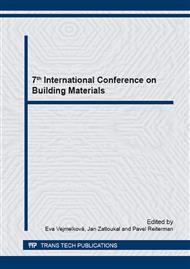[1]
A. E. Charola, Salts in the deterioration of porous materials: An overview, Journal of the American Institute for Conservation 39(3) (2000) pp.327-343.
DOI: 10.1179/019713600806113176
Google Scholar
[2]
Z. Pavlík, L. Fiala, M. Pavlíková, R. Cerný Coupled Water and Sulfate Transport Parameters of Materials Used in Historical Buildings. 8th symposium on Building Physics in the Nordic Countries. Copenhagen, Denmark. (2008).
Google Scholar
[3]
T. C. Chen, M. R. Yeung, N. Mori, Effect of water saturation on deterioration of welded tuff due to freeze-thaw action, Cold Regions Science and Technology 38(2-3) (2004) pp.127-136.
DOI: 10.1016/j.coldregions.2003.10.001
Google Scholar
[4]
D. Camuffo, Physical weathering of stones, Science of the Total Environment 167 (1995) pp.1-14.
Google Scholar
[5]
T. Warscheid, J. Braams, Biodeterioration of stone: A review, International Biodeterioration and Biodegradation 46(4) (2000) pp.343-368.
DOI: 10.1016/s0964-8305(00)00109-8
Google Scholar
[6]
J. E. Lindqvist, Rilem TC 203-RHM: Repair mortars for historic masonry. Testing of hardened mortars, a process of questioning and interpreting, Materials and Structures/Materiaux et Constructions 42(7) (2009) pp.853-865.
DOI: 10.1617/s11527-008-9455-x
Google Scholar
[7]
K. Terheiden, Diffusive and convective salt transport in building materials depending on pore solution concentration and moisture content, Journal of Building Physics 31(3) (2008) pp.199-211.
DOI: 10.1177/1744259107081806
Google Scholar
[8]
M. Steiger, Salts and crusts, in P. Brimblecombe (Eds. ), Air Pollution Reviews, Imperial College Press, London, 2, 2002, pp.133-181.
Google Scholar
[9]
E. Doehne, Salt weathering: A selective review, Geological Society Special Publication 205 (2002) pp.51-64.
DOI: 10.1144/gsl.sp.2002.205.01.05
Google Scholar
[10]
C. Rodriguez-Navarro, E. Doehne, Salt weathering: Influence of evaporation rate, supersaturation and crystallization pattern, Earth Surface Processes and Landforms 24(2-3) (1999) pp.191-209.
DOI: 10.1002/(sici)1096-9837(199903)24:3<191::aid-esp942>3.0.co;2-g
Google Scholar
[11]
R. P. J. van Hees, B. Lubelli, S. Naldini, V. Vergès-Belmin, A. Bourgès, F. Zezza, E. Di Sipio, A. Heritage, A. Sawdy, Guideline for desalination of porous substrates, (2013).
Google Scholar
[12]
A. Sawdy, A. Heritage, L. Pel, A review of salt transport in porous media, assessment methods and salt reduction treatments, Salt Weathering on Buildings and Stone Sculptures, 22-24 October 2008, The National Museum Copenhagen, Denmark, pp.1-27.
Google Scholar
[13]
P. Michálek, V. Tydlitát, M. Jerman, R. Černý, Desalination of historical masonry using hydrophilic mineral wool boards. WIT Transactions on Modelling and Simulation, Prague, (2007).
DOI: 10.2495/cmem070391
Google Scholar
[14]
A. C. Iñigo, S. Vicente-Tavera, V. Rives, MANOVA-Biplot Statistical Analysis of the Effect of Artificial Ageing (Freezing/Thawing) on the Colour of Treated Granite Stones, Color Research and Application 29(2) (2004) pp.115-120.
DOI: 10.1002/col.10236
Google Scholar
[15]
V. P. de Freitas, A. S. Guimarães, J. M. P. Q. Delgado The Humivent, device for rising damp treatment, Recent Patents on Engineering 5(3) (2011) 233-240.
DOI: 10.2174/187221211797636863
Google Scholar
[16]
V. Vergès-Belmin, Desalination of Porous Building Materials: a Review, European research on cultural heritage. State of the art studies. Proceedings of the ARCCHIP Workshop supported from the EC 5th FP Project No. ICA1-CT-2000-70013. S. Simon and M. Drdácký. Czech Republic, ITAM, Academy of Sciences of the Czech Republic. 5 (2006).
Google Scholar
[17]
I. Rörig-Dalgaard, Further developments of a poultice for electrochemical desalination of porous building materials: minimization of side effects, Materials and Structures (2014) Article in press.
DOI: 10.1617/s11527-014-0282-y
Google Scholar
[18]
M. Auras, Poultices and mortars for salt contaminated masonry and stone objects, Salt weathering on buildings and stone sculptures, Proceedings from the international conference, Technical University of Denmark, Department of Civil Engineering, Lyngby, (2008).
Google Scholar
[19]
A. Heritage, A. Sawdy, F. Funke, V. Verges-Belmin, A. Bourges How do conservators tackle desalination? An international survey of current poulticing methods. CHRESP: 8th EC Conference on Sustaining Europe's Cultural Heritage, Ljubljana, Slovenia, National and University library. (2008).
Google Scholar
[20]
A. Sawdy, B. Lubelli, V. Voronina, L. Pel, Optimizing the extraction of soluble salts from porous materials by poultices, Studies in Conservation 55(1) (2010) 26-40.
DOI: 10.1179/sic.2010.55.1.26
Google Scholar
[21]
L. Pel, A. Sawdy, V. Voronina, Physical principles and efficiency of salt extraction by poulticing, Journal of Cultural Heritage 11(1) (2010) 59-67.
DOI: 10.1016/j.culher.2009.03.007
Google Scholar
[22]
B. Lubelli, R. P. J. van Hees, H. De Clercq, Fine tuning of desalination poultices : Try-outs in practice, SWBSS 2011: Salt Weathering on Buildings and Stone Sculptures, Limassol, Cyprus, University of Cyprus.
Google Scholar
[23]
T. Lombardo, S. Simon, Laboratory Study on Desalination by Poultices, European research on cultural heritage. State of the art studies. Proceedings of the ARCCHIP Workshop supported from the EC 5th FP Project No. ICA1-CT-2000-70013. S. Simon and M. Drdácký. Czech Republic, ITAM, Academy of Sciences of the Czech Republic. 5 (2006).
Google Scholar
[24]
V. Vergès-Belmin, A. Heritage, A. Bourgès, Powdered cellulose poultices in stone and wall painting conservation myths and realities, Studies in Conservation 56(4) (2011) pp.281-297.
DOI: 10.1179/204705811x13159282692923
Google Scholar



